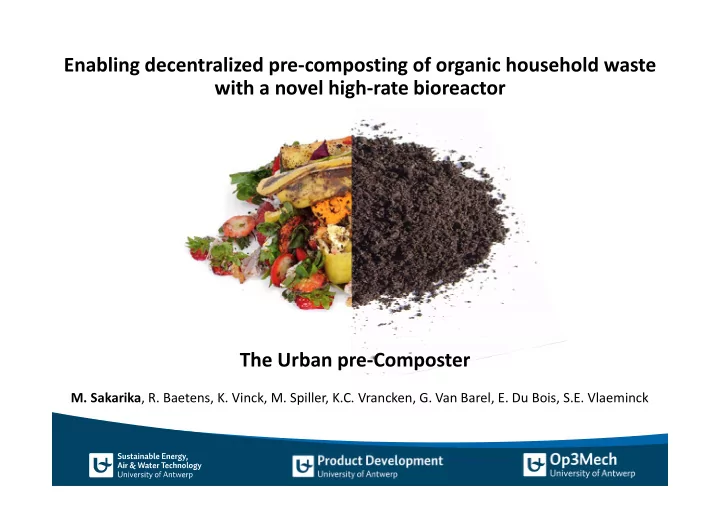

Enabling decentralized pre ‐ composting of organic household waste with a novel high ‐ rate bioreactor The Urban pre ‐ Composter M. Sakarika , R. Baetens, K. Vinck, M. Spiller, K.C. Vrancken, G. Van Barel, E. Du Bois, S.E. Vlaeminck
Fate of organic household waste in Flanders anaerobic digestion landfilling 6% 2% composting incineration 40% 24% conversion to animal feed 28% [Reference period: 2015] (Roels et al., 2017) 2
Cost breakdown composting composting process 26% collection and transport 74% [Reference period: 2009] (Kaza et al., 2016) 3
Urban household organic waste composition • Household organic waste: vegetables, green, fruit (VGF) • Urban household organic waste : mainly kitchen waste • Composition of waste disposed in the collection points of the Flanders: dairy products (yogurt) meat, fish and poultry 4% 4% sauces, herbs and spices prepared dishes 1% 6% vegetables bread 35% 15% fruit 35% 4
Conventional organic waste flow Collection point Organic household waste High transportation High capacity requirements for requirements centralized composting Mobility problems (traffic) Air pollution Odor Noise 5
Novel organic waste flow with the Urban pre ‐ Composter Requirements : space limitation compact (high ‐ rate) • practical allow for loading/unloading • • minimal use of resources (bulking agents; water) Collection point Organic household waste Reduced capacity requirements for Reduced transportation requirements centralized main composting Decentralized, high ‐ rate pre ‐ composting Goal: max. mass and volume reduction in 2 weeks 6
Challenges in composting kitchen waste Kitchen waste 67 ‐ 85% moisture 2 lack of structure poor oxygen high leachate addition of structure diffusion generation material 2 (Nair et al. 2006); (Yang et al. 2013) 7 [picture from: www.thebulletingredients.com]
Research objectives 1. Develop a prototype Urban pre ‐ composter and validate achievable mass and volume reduction of kitchen waste 2. Extrapolate to efficiency gains in the overall kitchen waste treatment (pre ‐ composting + main composting) 3. Characterize final compost quality 8
Reactor design nozzle for optional air outlet wetting with leachate pipe waste load/unload point aerator inlet points motor to rotate agitator static barrel leachate collection (200L) reservoir leachate drainage agitator tube • Continuous loading drum bioreactor with forced aeration and internal agitation • Capacity: kitchen waste from 44 persons (4.5 L/person) 9
Agitator design waste load/unload point motor to rotate agitator static barrel (200L) Design 1 : straight scraper Design 2 : battlemented with internal void scraper with internal bars agitator (Runs 1 and 2) (Runs 3 and 4) 10
Urban pre ‐ composter performance 70 60 50 % Reductions 33% reduction batch in 28 days 40 (Yang et al. 2013) 30 20 10 0 Fresh weight Volatile solids (VS) Moisture Volume Run 1 Run 2 Run 3 Run 4 Kitchen waste Formulated Real Sawdust No Yes No Agitator design 11
Water balance 100 80 60 % 40 20 0 Run 1 Run 2 Run 3 Run 4 Evaporation Leachate Waste • Minor water removal from leaching • Moisture content 56 ‐ 75% above 55%, so no need for moistening 3 3 (Nair et al., 2006) 12
Leachate generation Passive aeration 300 270 Active aeration Leachate generation (mL/kg FM ) 250 200 Worse case: 400 persons generate 3.5L vs 135L 130 150 100 50 7 2 4 4 0 Run 1 Run 2 Run 3 Run 4 Andersen et al., Amlinger et al., 2011 2008 • Low amounts of leachate • Can be added to compost (negligible moisture content increase 0.8 ‐ 1.1%) no separate collection • Upscaling: trade ‐ off between energy use (aeration; evaporation) and leachate production 13
Research objectives 1. Develop a prototype Urban pre ‐ Composter and validate achievable mass and volume reduction of kitchen waste 2. Extrapolate to efficiency gains in the overall kitchen waste treatment (pre ‐ composting + main composting) 3. Characterize final compost quality 14
Overall treatment: pre ‐ composting + main composting 100 80 60 +16% 40 Fed ‐ batch, 67 days (Amlinger et al., 2008) 20 0 Fresh weight Volume Time (days) reduction (%) reduction (%) pre ‐ composting main composting • High ‐ rate conversions during pre ‐ composting • 42% and 71% of overall mass and volume reduction potential achieved in 21% of the time 15
Research objectives 1. Develop a prototype Urban pre ‐ Composter, and validate achievable mass and volume reduction of kitchen waste 2. Extrapolate to efficiency gains in the overall kitchen waste treatment (pre ‐ composting + main composting) 3. Characterize final compost quality 16
Compost quality Requirements Produced VGF compost for solid Parameter Unit composition 4 compost organic fertilizers 5 Total solids (TS) %g TS /g product 26.8 70 >40 C/N ‐ 11.8 12 <15 N %g N /g product 0.85 1.2 2.5 P %g P /g product 0.13 0.13 0.44 K %g K /g product 0.07 0.42 0.83 N/P/K ‐ 1/0.15/0.08 1/0.11/0.35 1/0.18/0.33 • Final moisture removal is needed • C/N ratio indicates near mature compost after 68 days • Good N/P ratio 4 VLACO; 5 (European Commission, 2016) 17
Conclusions 33% mass reduction Collection point Organic household waste Reduced capacity requirements for Reduced transportation centralized main composting requirements Urban pre ‐ composting (400 PE: 2.5 m 3 ) • Successfully demonstration of the effectiveness and feasibility of urban pre ‐ composting at semi ‐ technical scale (200L) • No bulking agent addition, no need for separate leachate collection no additional cost for logistics and management • 42% and 71% of the overall mass and volume reduction potential achieved in 14 days • The urban pre ‐ composter lowers overall costs of organic waste management 18
Thank you for your attention! Myrsini.Sakarika@UAntwerpen.be – Siegfried.Vlaeminck@UAntwerpen.be 19 Financial support by
Back ‐ up slides 20
Neighborhood level waste collection Sorting streets for 400 persons (250 families) 21
Composting of real kitchen waste 60 Run 4 50 40 Mass (kg) 30 20 10 0 0 2 4 6 8 10 12 14 Time (days) Mimicking of realistic feeding (fed ‐ batch) not full reduction potential (compared to batch process) 22
Recommend
More recommend